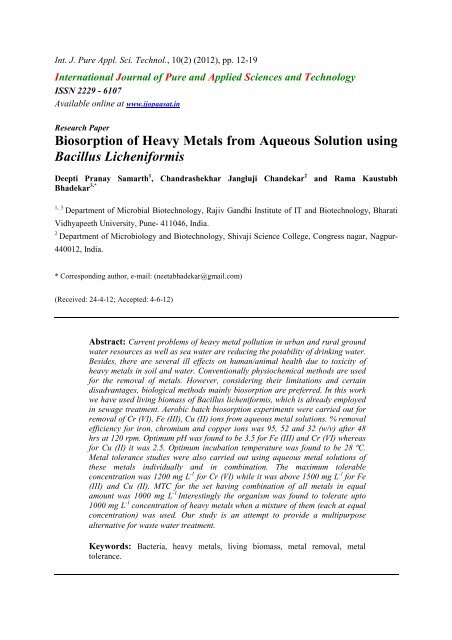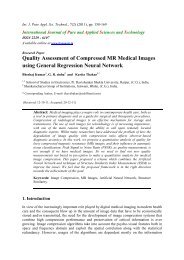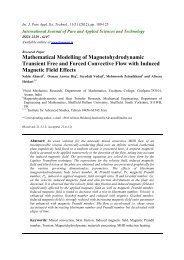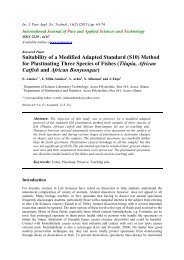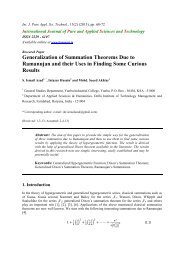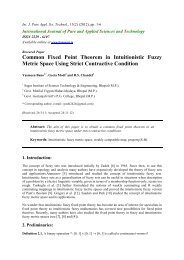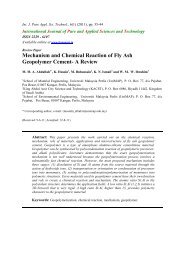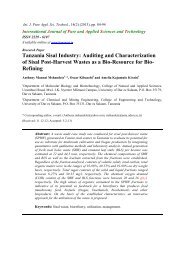Biosorption of Heavy Metals from Aqueous Solution using Bacillus Licheniformis
Biosorption of Heavy Metals from Aqueous Solution using Bacillus ...
Biosorption of Heavy Metals from Aqueous Solution using Bacillus ...
- No tags were found...
Create successful ePaper yourself
Turn your PDF publications into a flip-book with our unique Google optimized e-Paper software.
Int. J. Pure Appl. Sci. Technol., 10(2) (2012), pp. 12-19<br />
International Journal <strong>of</strong> Pure and Applied Sciences and Technology<br />
ISSN 2229 - 6107<br />
Available online at www.ijopaasat.in<br />
Research Paper<br />
<strong>Biosorption</strong> <strong>of</strong> <strong>Heavy</strong> <strong>Metals</strong> <strong>from</strong> <strong>Aqueous</strong> <strong>Solution</strong> <strong>using</strong><br />
<strong>Bacillus</strong> <strong>Licheniformis</strong><br />
Deepti Pranay Samarth 1 , Chandrashekhar Jangluji Chandekar 2<br />
Bhadekar 3,*<br />
and Rama Kaustubh<br />
1, 3<br />
Department <strong>of</strong> Microbial Biotechnology, Rajiv Gandhi Institute <strong>of</strong> IT and Biotechnology, Bharati<br />
Vidhyapeeth University, Pune- 411046, India.<br />
2<br />
Department <strong>of</strong> Microbiology and Biotechnology, Shivaji Science College, Congress nagar, Nagpur-<br />
440012, India.<br />
* Corresponding author, e-mail: (neetabhadekar@gmail.com)<br />
(Received: 24-4-12; Accepted: 4-6-12)<br />
Abstract: Current problems <strong>of</strong> heavy metal pollution in urban and rural ground<br />
water resources as well as sea water are reducing the potability <strong>of</strong> drinking water.<br />
Besides, there are several ill effects on human/animal health due to toxicity <strong>of</strong><br />
heavy metals in soil and water. Conventionally physiochemical methods are used<br />
for the removal <strong>of</strong> metals. However, considering their limitations and certain<br />
disadvantages, biological methods mainly biosorption are preferred. In this work<br />
we have used living biomass <strong>of</strong> <strong>Bacillus</strong> licheniformis, which is already employed<br />
in sewage treatment. Aerobic batch biosorption experiments were carried out for<br />
removal <strong>of</strong> Cr (VI), Fe (III), Cu (II) ions <strong>from</strong> aqueous metal solutions. % removal<br />
efficiency for iron, chromium and copper ions was 95, 52 and 32 (w/v) after 48<br />
hrs at 120 rpm. Optimum pH was found to be 3.5 for Fe (III) and Cr (VI) whereas<br />
for Cu (II) it was 2.5. Optimum incubation temperature was found to be 28 ºC.<br />
Metal tolerance studies were also carried out <strong>using</strong> aqueous metal solutions <strong>of</strong><br />
these metals individually and in combination. The maximum tolerable<br />
concentration was 1200 mg L -1 for Cr (VI) while it was above 1500 mg L -1 for Fe<br />
(III) and Cu (II). MTC for the set having combination <strong>of</strong> all metals in equal<br />
amount was 1000 mg L -1. Interestingly the organism was found to tolerate upto<br />
1000 mg L -1 concentration <strong>of</strong> heavy metals when a mixture <strong>of</strong> them (each at equal<br />
concentration) was used. Our study is an attempt to provide a multipurpose<br />
alternative for waste water treatment.<br />
Keywords: Bacteria, heavy metals, living biomass, metal removal, metal<br />
tolerance.
Int. J. Pure Appl. Sci. Technol., 10(2) (2012), 12-19. 13<br />
Introduction:<br />
Certain species <strong>of</strong> micro organisms have found to adsorb surprisingly large quantities <strong>of</strong> heavy metals.<br />
Many <strong>of</strong> these metals include those ca<strong>using</strong> toxicity to humans and metals <strong>of</strong> commercial and<br />
economic importance. Removal <strong>of</strong> metals and their recovery is one <strong>of</strong> the major concerns in sewage<br />
and industrial effluent treatment, which is both in municipal and industrial interest. The heavy metals<br />
<strong>of</strong> widespread concern to human health are mercury, cadmium, lead, arsenic, chromium, copper, and<br />
zinc (Lazrova et al., 2005). Nriagu (1988) estimated that over one billion human beings are currently<br />
exposed to elevated concentrations <strong>of</strong> toxic metals and metalloids in the environment and several<br />
million people may be suffering <strong>from</strong> subclinical metal poisoning. Adverse effect <strong>of</strong> heavy metals<br />
include i) suppression <strong>of</strong> the immune system ii) carcinogenicity (Peakall, 1992), iii) neurotoxicity,<br />
mainly in children (Cohen, 2005) iv) inhibition <strong>of</strong> the activity <strong>of</strong> some critical enzymes related to<br />
synthesis <strong>of</strong> vital bio-molecules v) accumulation in the body <strong>of</strong> different organisms ca<strong>using</strong> biomagnification<br />
(Paknikar et al., 2003).<br />
Physico-chemical methods, such as chemical precipitation, oxidation or reduction, electrochemical<br />
treatment, evaporative recovery, filtration, ion exchange and membrane technologies are widely used<br />
to remove heavy metal ions <strong>from</strong> industrial wastewater. However, application <strong>of</strong> these treatment<br />
processes has been found to be sometimes restricted, because <strong>of</strong> investment, operational costs and the<br />
potential generation <strong>of</strong> secondary pollution. These processes may be ineffective or expensive,<br />
especially when the heavy metal ion concentrations in solutions are 1-100 mg L -1 (Volesky, 1990a, b).<br />
It was only in the 1990s that a new scientific area developed that could help to recover heavy metals<br />
<strong>using</strong> biological means i.e. biosorption. The first reports described how abundant biological materials<br />
could be used to remove; at very low cost, even small amounts <strong>of</strong> toxic heavy metals <strong>from</strong> industrial<br />
effluents (Vieira and Volesky 2000). The technique <strong>of</strong> biosorption utilizes the characteristics <strong>of</strong><br />
microoganisms to adsorb metals in a commercial manner. Microorganisms uptake metal, either<br />
actively (bioaccumulation) and/or passively (biosorption) (Fourest and Roux, 1992). This is due to<br />
affinity <strong>of</strong> bacterial surfaces for heavy metals leading to their adsorption and precipitation. The<br />
biosorption is passive non-metabolic process <strong>of</strong> binding various chemicals on biomass (Volesky,<br />
1990a). Most studies <strong>of</strong> biosorption for metal removal deal with the use <strong>of</strong> either laboratory-grown<br />
microorganisms or biomass generated by the pharmacology and food processing industries or<br />
wastewater treatment units (Tsezos and Volesky, 1981; Hussein et al. 2004).<br />
<strong>Bacillus</strong> licheniformis (B.licheniformis) is frequently used in waste water treatment in combination<br />
with <strong>Bacillus</strong> subtilis (Hiatt 2000, Kalia et al. 1994) due to the production <strong>of</strong> extracellular enzymes,<br />
mainly protease and lipase. The extraordinary characters <strong>of</strong> organism which support its application in<br />
sewage treatment are its diverse habitat, ease <strong>of</strong> cultivation, non pathogenic nature to humans, spore<br />
forming ability and its tolerance to environmental stress, starvation etc. There are many reports<br />
describing metal binding sites <strong>of</strong> B. licheniformis. Other than peptidoglycan (basic component <strong>of</strong> cell<br />
wall), B. licheniformis cell wall has high proportion <strong>of</strong> teichoic and teichouronic acid, both <strong>of</strong> which<br />
are responsible for about 60% <strong>of</strong> metal binding (Beveridge, 1982).<br />
These characteristics <strong>of</strong> B.licheniformis prompted us to study efficacy <strong>of</strong> its living biomass in heavy<br />
metal removal. This work mainly deals with biosorption <strong>of</strong> hexavalent chromium ion, cupric ion and<br />
ferric ion by whole cell broth <strong>of</strong> B.licheniformis (NCIM 2471). Effects <strong>of</strong> change in pH and<br />
incubation temperature on metal removal were also studied. Our studies also aimed at determination<br />
<strong>of</strong> heavy metal tolerance <strong>of</strong> the organism <strong>using</strong> the metal ions individually and in combination.<br />
Materials and Methods:<br />
All the chemicals were procured <strong>from</strong> Merck, India and were <strong>of</strong> A.R grade whereas all media<br />
components were <strong>from</strong> Hi Media, India. B. licheniformis (NCIM 2471) was obtained <strong>from</strong> National<br />
Collection <strong>of</strong> Industrial Microorganisms, National Chemical Laboratory, Pune, India. The strain was<br />
maintained by subculturing on nutrient agar. The culture was stored at 4° C between transfers and<br />
subcultured before experimental use.
Int. J. Pure Appl. Sci. Technol., 10(2) (2012), 12-19. 14<br />
Metal <strong>Solution</strong>s:<br />
Experimental metals used in the study were chromium (VI), copper (II) and iron (III) in the form <strong>of</strong><br />
their respective metal solutions. A synthetic multi-element standard solution <strong>of</strong> liquid media (1%<br />
tryptone, 0.5% yeast extract, 0.5% NaCl) containing 150 mg L -1 <strong>of</strong> each Cr, Cu and Fe ions was<br />
prepared <strong>from</strong> their respective stock solutions (1000 mg L -1 ). Chemicals used for preparing these<br />
stock solutions where potassium dichromate, copper sulphate and ferric chloride. Stock solutions <strong>of</strong><br />
these metals were prepared <strong>using</strong> deionized water and autoclaved separately. Prior to addition <strong>of</strong> stock<br />
solution <strong>of</strong> metals the liquid media were autoclaved at 121°C for 20 min. All the additions were<br />
performed aseptically.<br />
Effect <strong>of</strong> pH on <strong>Biosorption</strong>:<br />
The experiments were carried out in the batch mode for the measurement <strong>of</strong> biosorption capabilities.<br />
Medium containing synthetic multi-element solution (15 mg % <strong>of</strong> each metal) in 500 ml Erlenmeyer<br />
flask was used. Before the addition <strong>of</strong> the biosorbant inoculum to the solution the samples were<br />
adjusted to different pH values viz. pH- 2.5, 3, 3.5, 4, 4.5. The pH <strong>of</strong> solution was adjusted with 1 M<br />
HCl and 1 M NaOH solutions. Samples were inoculated with 10% overnight grown culture <strong>of</strong><br />
B.licheniformis and then incubated at 120 rpm for 48 hrs. The inoculated samples were then incubated<br />
at 28°C for 48 hrs. After the incubation period the cells were harvested by centrifugation for 30 min at<br />
5000 rpm. Total metal concentration biosorbed by B. licheniformis was analysed <strong>using</strong> Inductive<br />
Coupled Plasma-Atomic Emission Spectrophotometer (ICP-AES) (JY-24, Jobin yvon, France).<br />
Effect <strong>of</strong> Incubation Temperature on <strong>Biosorption</strong>:<br />
A set <strong>of</strong> three samples was prepared as described above and pH was adjusted to 3.5 for all three<br />
samples. After inoculation, samples were incubated at temperatures i.e. 20°C, 28°C, 37°C respectively<br />
and incubated at 120 rpm for 48 hrs. Total metal concentration biosorbed by B. licheniformis was<br />
analyzed <strong>using</strong> ICP-AES as described above.<br />
Determination <strong>of</strong> Metal Tolerance:<br />
Colorimetric method was used to determine maximum tolerable concentration (MTC) <strong>of</strong> B.<br />
licheniformis for hexavalent chromium ion, cupric ion and ferric ion. Four sets <strong>of</strong> experiments were<br />
prepared <strong>using</strong> liquid media as mentioned above. First three sets had varying concentrations (200 mg<br />
L -1 to 1500 mg L -1 ) each <strong>of</strong> chromium, cupric and ferric ion respectively. In the fourth set, the samples<br />
contained all metal ions in the range <strong>of</strong> 200 mg L -1 to 1500 mg L -1 . Thus total metal concentration<br />
varied <strong>from</strong> 600 mg L -1 to 4500 mg L -1 in the samples in fourth set <strong>of</strong> experiments. The pH was<br />
maintained at 3.5 for all four sets. 10 % overnight grown culture <strong>of</strong> B. licheniformis was inoculated in<br />
these samples and incubated at 28°C, 120 rpm for 48 hrs.<br />
Growth was determined by measuring absorbance at 540 nm. Samples showing zero absorbance were<br />
further confirmed for growth by examining total viable count (TVC). Maximum tolerable<br />
concentration (MTC) <strong>of</strong> heavy metal was designated as the highest concentration <strong>of</strong> heavy metal that<br />
allowed growth after 2 days (Schmidt and Schlegal, 1994). All the experiments were carried out in<br />
triplicates and the results indicate the mean values.<br />
Results and Discussion:<br />
<strong>Biosorption</strong> Studies:<br />
The living biomass <strong>of</strong> B. licheniformis (NCIM 2471) was used for biosorption studies <strong>of</strong> Cr (VI), Cu<br />
(II) and Fe (III) ions. Effect <strong>of</strong> pH and incubation temperature was studied on removal efficiency <strong>of</strong><br />
the organism.
Int. J. Pure Appl. Sci. Technol., 10(2) (2012), 12-19. 15<br />
Effect <strong>of</strong> pH:<br />
The pH <strong>of</strong> the solution is the most critical parameter for metal sorption as it influences both the<br />
bacterial surface chemistry as well as solution chemistry <strong>of</strong> soluble metal ion. Different metals show<br />
different pH optima for their biosorption (Donmez et al. 1999; Saeed and Iqbal 2003).<br />
Fig.1 shows % removal <strong>of</strong> heavy metal ions at pH- 2.5, 3, 3.5, 4, 4.5. It was found to be in the range<br />
<strong>of</strong> 14 – 95 %. Maximum biosorption was observed at pH 3.5 for iron and chromium ion with removal<br />
efficiency <strong>of</strong> 95% and 52% respectively. pH 2.5 was found to be optimum for Cu ion giving the<br />
maximum removal efficiency <strong>of</strong> 32%. The results suggested that acidic pH (2.5 to 3.5) was optimum<br />
for biosorption <strong>of</strong> these heavy metals <strong>using</strong> B.licheniformis. Among the three metal ions removal<br />
efficency for iron (63-95 %) was found to be maximum.<br />
Zhou et al, (2007) have also reported acidic pH optimum (pH 2.5) for Cr (VI) ion <strong>using</strong> dead biomass<br />
<strong>of</strong> B. licheniformis isolated <strong>from</strong> polluted soil sample with 85 % metal removal efficency. B.<br />
licheniformis CCO1 reported by Clausen (2000) exhibited removal efficiency <strong>of</strong> 93% and 8% for<br />
copper and chromium respectively. However our results indicated 60% removal efficiency when a<br />
mixture <strong>of</strong> Cr (VI), Cu (II) and Fe (III) ions was used. This showed higher metal removal efficiency<br />
<strong>of</strong> living biomass <strong>of</strong> B. licheniformis (NCIM 2471), thereby suggesting its possible application in<br />
multiple metal removal in effluent treatment.<br />
Effect <strong>of</strong> Incubation Temperature:<br />
Fig.2 shows effect <strong>of</strong> incubation temperature on metal biosorption. Maximum % removal <strong>of</strong> metal ion<br />
was observed at 28°C. Removal efficiencies were 95%, 52% and 38% for Fe (III), Cr (VI) and Cu (II)<br />
respectively at 28°C. Such high binding efficiency <strong>of</strong> iron ion by B.licheniformis was also reported by<br />
Beveridge et al. (1982). Teichoic acid, teichouronic acid and peptidoglycan were shown to be<br />
important biomolecules involved in metal binding as mentioned earlier. Iron binding was found to be<br />
reduced by 38% when teichoic acid was removed and by 60 % when both teichoic acid and<br />
teichouronic acid were removed. McLean et al. (1990) observed similar results in uptake <strong>of</strong> iron and<br />
suggested participation <strong>of</strong> gamma-glutamyl capsular polymer <strong>of</strong> the organism, other than these<br />
biomolecules. To our knowledge this is the first report showing 95% biosorption <strong>of</strong> iron <strong>using</strong> living<br />
cells <strong>of</strong> B.licheniformis.<br />
Determination <strong>of</strong> MTC:<br />
Using colorimetric method, MTC <strong>of</strong> B.licheniformis for three metal ions viz. hexavalent chromium<br />
ion, cupric ion, ferric ion and for mixture <strong>of</strong> these three metal ions in a same sample were determined<br />
(Fig 3). As indicated in fig.3, MTC for hexavalent chromium ion was 1200 mg L -1. In case <strong>of</strong> cupric<br />
ion and ferric ion, the MTC was above 1500 mg L -1 , whereas the MTC for set having mixture <strong>of</strong> all<br />
the metal in a sample was 1000 mg L -1 . These results suggested that the organism has high metal<br />
tolerance for copper and iron as compared to chromium. In light <strong>of</strong> our observations, living biomass<br />
<strong>of</strong> B.licheniformis could be used efficiently and effectively in removal <strong>of</strong> heavy metals <strong>from</strong> effluents.<br />
Conclusions<br />
Our results demonstrated that the use <strong>of</strong> live cells <strong>of</strong> B.licheniformis in waste water treatment would<br />
prove an eco-friendly, multipurpose and cost efficient alternative to conventional methods. This work<br />
will be helpful in i) developing technologies useable for in situ bioremediation <strong>using</strong> B.licheniformis<br />
ii) construction <strong>of</strong> large scale bioreactor iii) promoting its detail study <strong>of</strong> binding mechanism and<br />
other technological parameters to improve the feasibility in the process application.
Int. J. Pure Appl. Sci. Technol., 10(2) (2012), 12-19. 16<br />
Acknowledgement<br />
The authors are indebted to Analytical instrumentation division, National Environmental Engineering<br />
Research Institute, Nagpur for providing us the analytical facility.<br />
Figures<br />
100<br />
90<br />
80<br />
70<br />
% Rem o val o f m etal io n<br />
60<br />
50<br />
40<br />
30<br />
Ferrous ions<br />
Chromium (VI) ion<br />
Cupric ion<br />
20<br />
10<br />
0<br />
2.5 3 3.5 4 4.5<br />
pH<br />
Fig.1
Int. J. Pure Appl. Sci. Technol., 10(2) (2012), 12-19. 17<br />
100<br />
90<br />
80<br />
Ferrous ions<br />
% Rem oval <strong>of</strong> m etal ion<br />
70<br />
60<br />
50<br />
40<br />
30<br />
Chromium (VI) ion<br />
Cupric ion<br />
20<br />
10<br />
0<br />
20 28 37<br />
Temperature ( o C)<br />
Fig.2
Int. J. Pure Appl. Sci. Technol., 10(2) (2012), 12-19. 18<br />
2<br />
1.8<br />
1.6<br />
Absorbance (O.D. at 540 n m)<br />
1.4<br />
1.2<br />
1<br />
0.8<br />
0.6<br />
0.4<br />
Ferrous ions<br />
Chromium (VI) ion<br />
Cupric ion<br />
Mixure <strong>of</strong> all three metal<br />
ions<br />
0.2<br />
0<br />
200 500 700 1000 1200 1500<br />
Concentration <strong>of</strong> metal ion (mg L -1 )<br />
Fig .3<br />
References<br />
[1] T.J. Beveridge, C.W. Forsberg and J. Doyle, Major sites <strong>of</strong> metal binding in <strong>Bacillus</strong><br />
<strong>Licheniformis</strong> walls, Journal <strong>of</strong> Bacteriology, 150(1982), 1438-1448.<br />
[2] C.A. Clausen, Isolating metal-tolerant bacteria capable <strong>of</strong> removing copper, chromium and<br />
arsenic <strong>from</strong> treated wood, Waste Management Resource, 18(2000), 264-268.<br />
[3] D. Cohen, Lead poisoning in environment and our children, (2005), URL<br />
http:///www.links2health.com<br />
[4] G.C. Donmez, Z. Aksu , A. Ozturk and T.A. Kutsal, Comparative study on heavy metal<br />
biosorption characteristics <strong>of</strong> some algae, Process Biochemistry, 34(1999), 885–892<br />
[5] E. Fourest, C.J. Roux, <strong>Heavy</strong> metal biosorption by fungal mycilial by- products: Mechanisms<br />
and influence <strong>of</strong> pH, Applied Microbiology and Biotechnology, 37(1992), 399-403.<br />
[6] W.N. Hiatt, Denitrifying bacterial preparation and method, US Patent No.6025152, 2000.<br />
[7] H. Hussein, S.F. Ibrahim, K. Kandeel and H. Moawad, <strong>Biosorption</strong> <strong>of</strong> heavy metals <strong>from</strong><br />
waste water <strong>using</strong> Pseudomonas sp, Electronic Journal <strong>of</strong> Biotechnology, 7(1) (2004).<br />
[8] V.C. Kalia, S.R. Jain and Kumar, Fermentation <strong>of</strong> biowaste to H 2 by <strong>Bacillus</strong> <strong>Licheniformis</strong>,<br />
World Journal <strong>of</strong> Microbiology and Biotechnology, 10(1994), 224-227.<br />
[9] V. Lazarova, H. Bouwer and A. Bahri, Water quality consideration, In: V. Lazarova and A.<br />
Bahri (eds.), Water Reuse for Irrigation: Agriculture, Landscapes, and Turf Grasses, CRC<br />
Press, Boca Raton, FL, 2005.
Int. J. Pure Appl. Sci. Technol., 10(2) (2012), 12-19. 19<br />
[10] R.J.C. McLean, D. Beauchemin, L. Clapham and T.J. Beveridge, Metal-binding<br />
characteristics <strong>of</strong> the gamma-glutamyl capsular polymer <strong>of</strong> <strong>Bacillus</strong> <strong>Licheniformis</strong> ATCC<br />
9945, Applied and Environmental Microbiology, 56(1990), 3671-3677.<br />
[11] J.O. Nriagu, A silent epidemic <strong>of</strong> environmental metal poisoning, Environmental Pollution,<br />
50(1988), 139-161.<br />
[12] K.M. Paknikar, A.V. Pethkar and P.R. Puranik, Bioremediation <strong>of</strong> metalliferous wastes and<br />
products <strong>using</strong> inactivated microbial biomass, Indian Journal <strong>of</strong> Biotechnology, 2(2003), 426-<br />
443.<br />
[13] D. Peakall, Animal Biomarkers as Pollution Indicators, Chapman and Hall, London, 1992.<br />
[14] A. Saeed and M. Iqbal, Bioremoval <strong>of</strong> cadmium <strong>from</strong> aqueous solution by black gram husk<br />
(Cicer arientinum), Water Resource, 37(2003), 3472-3480.<br />
[15] T. Schmidt and H.G. Schlegel, Combined nickel-cobalt-cadmium resistances encoded by the<br />
ncc locus <strong>of</strong> Alcaligens xylosoxidans 31A, Journal <strong>of</strong> Bacteriology, 176(1994), 7054-7054.<br />
[16] M. Tsezos and B. Volesky, <strong>Biosorption</strong> <strong>of</strong> uranium and thorium, Biotechnology and<br />
Bioengineering, 24(1981), 385-401.<br />
[17] B. Volesky, <strong>Biosorption</strong> and biosorbents, In : B. Volesky (eds), <strong>Biosorption</strong> <strong>of</strong> <strong>Heavy</strong> <strong>Metals</strong>,<br />
CRC Press, Boston, USA, 1990a.<br />
[18] B. Volesky, Removal and recovery <strong>of</strong> heavy metals by biosorption, In: B. Volesky (eds),<br />
<strong>Biosorption</strong> <strong>of</strong> <strong>Heavy</strong> <strong>Metals</strong>, CRC Press, Boston, USA, 1990b.<br />
[19] R. Vieira and B. Volesky, <strong>Biosorption</strong>: A solution to pollution? International Microbiology,<br />
3(2000), 17–24.<br />
[20] M. Zhou, Y. Liu, G. Zeng, X. Li, W. Xu and T. Fan, Kinetic and equilibrium studies <strong>of</strong> Cr<br />
(VI) biosorption by dead <strong>Bacillus</strong> <strong>Licheniformis</strong> biomass, World Journal <strong>of</strong> Microbiology and<br />
Biotechnology, 23(2007), 43-48.


